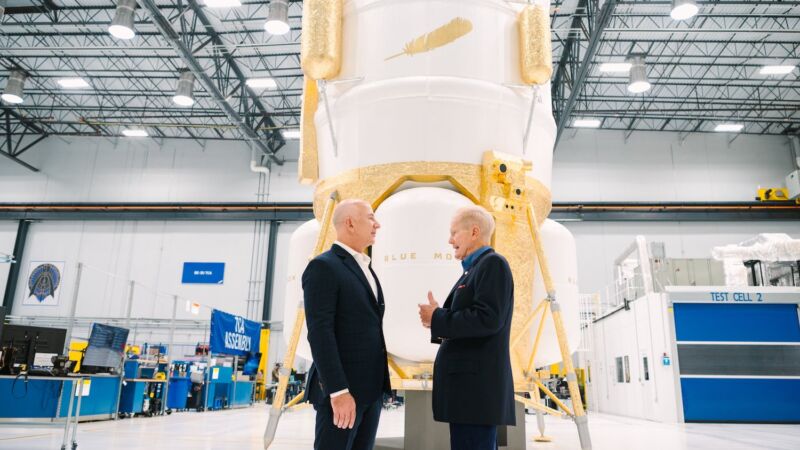
Blue Origin has unveiled a mock-up of the Blue Moon lander it says will be ready to fly to the Moon within the next three years as a precursor to human landings on a larger vehicle, perhaps at the end of the decade.
Jeff Bezos, the billionaire founder of Blue Origin, recently showed off the “low-fidelity” mock-up to NASA officials at the company’s engine production facility in Huntsville, Alabama. The vehicle is undoubtedly large and will take advantage of the 23-foot-wide (7-meter) payload volume on Blue Origin’s New Glenn rocket.
This is the Mark 1 variant of the Blue Moon lander. It’s designed to deliver up to 3 metric tons (about 6,600 pounds) of cargo anywhere on the lunar surface. Blue Origin revealed the design on Friday.
“Blue Moon Mark 1 is a single-launch, lunar cargo lander that remains on the surface and provides safe, reliable, and affordable access to the lunar environment,” Blue Origin wrote on its website. The company is developing the Mark 1 as a predecessor to the larger Mark 2 lander, which will ferry astronauts to and from the lunar surface under contract to NASA, which selected Blue Origin as its second human-rated lunar lander contractor in May, alongside SpaceX.
“We’re building our landers, both our Mark 1 and our Mark 2, to enable global landing capability on the Moon, day or night,” said John Couluris, senior vice president of lunar transportation at Blue Origin.
Schedule uncertainty
NASA’s first landing target for Artemis is the lunar south pole, where scientists have discovered evidence for large deposits of water ice in the bottoms of dark craters. There’s a lot of work to do before that happens.
With its $3.4 billion fixed-price Human Landing System (HLS) contract with NASA, Blue Origin will be responsible for transporting astronauts between lunar orbit and the surface of the Moon, then back into space, on the Artemis V mission. This mission is officially scheduled for no sooner than 2029, but is likely to slip into the 2030s.
NASA has contracted with SpaceX for two crew lunar landings with its giant Starship vehicle on the Artemis III and Artemis IV missions, officially slated for late 2025 and 2028. Those missions are also likely to be delayed, with schedule pressures ranging from the readiness of the Starship lander and spacesuits to the construction of a new mobile launch platform and an enlarged upper stage for NASA’s Space Launch System rocket.
SpaceX’s priority, for now, is to get the Starship rocket into orbit, and then the company needs to test refueling technology in space, a capability that will require numerous successful Starship launches. Then SpaceX plans to fly an unpiloted demonstration mission to land Starship on the Moon, ahead of the first crew flight.
It’s not just SpaceX’s readiness that concerns NASA about the schedule for Artemis III.
“We have a whole bunch of components that have to come together for (Artemis) III,” said Jim Free, the senior NASA manager who oversees the Artemis program. “We’ve got a whole new Orion that’s going to have a docking system on it … We should never rest on our laurels on SLS. That’s got to come together because we build a whole new vehicle every time.
“We need suits to come together, and as the suits are very much in their early technical phase of design and development, nobody should rest easy,” Free said.
“Every single contractor has got to perform on every mission, and they have to do it to a higher level than they ever have because now we’re flying humans,” he said.

